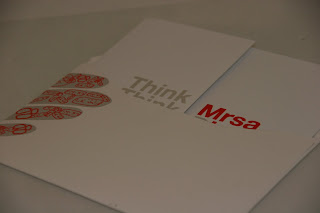Today we were looking at physically making the contrasting colour. We had to collect 1 sheet of coloured paper for each colour and cut out a 10x10 square for each. We then had to cut out more squares and then cut them into 5x5, We then placed these on a white piece of paper so as to not distract from the other colours as we layered them up. We were then told to place specific squares on each square and see the reaction. Within this session we took a lot of photographs so what i have done is take 10 examples from each part of the session and discuss them briefly. Original stack of paper. Just showing what we had to do.
Original stack of paper. Just showing what we had to do. the blue and red show contrast while the green and red show complimentary - this shows a secondary with a primary, primary colour will always stand out and if you get two primarys (red and blue) then they will fight.
the blue and red show contrast while the green and red show complimentary - this shows a secondary with a primary, primary colour will always stand out and if you get two primarys (red and blue) then they will fight. Nothing happens with these colours they are completely flat as there is no contraast.
Nothing happens with these colours they are completely flat as there is no contraast. With this you'd expect to see the colours fight which they do a bit but the black controls them so it stops the colours fighting and bouncing.
With this you'd expect to see the colours fight which they do a bit but the black controls them so it stops the colours fighting and bouncing. With the yellow on black the yellow holds down and makes it flatter. Wherteas with black on yellow makes the yellow look brighter.
With the yellow on black the yellow holds down and makes it flatter. Wherteas with black on yellow makes the yellow look brighter. This image shows neutrality, the squares aren't bouncing. Colours look flat.
This image shows neutrality, the squares aren't bouncing. Colours look flat. With this the red looks darker and the orange warms up.
With this the red looks darker and the orange warms up. The orange begins to look lighter because of the yellow sqaure.
The orange begins to look lighter because of the yellow sqaure. Shows neutrality, white doesn't bring or take anything away.
Shows neutrality, white doesn't bring or take anything away.
 These are the set of arrows that i cut out in different sizes and shapes to help with variation.
These are the set of arrows that i cut out in different sizes and shapes to help with variation. the red on black makes the red appear darker and gives a sense of danger.
the red on black makes the red appear darker and gives a sense of danger. The red on yellow shows neautrality and doesn't look too dark. gives a sort of pleasing image.
The red on yellow shows neautrality and doesn't look too dark. gives a sort of pleasing image. This looks like a warning sign with the association of red and white.
This looks like a warning sign with the association of red and white. Here we were trying out what a lot of colour on another would do to one another, here it shows that the colours rally fight against one another because of the fact they are two primaries.
Here we were trying out what a lot of colour on another would do to one another, here it shows that the colours rally fight against one another because of the fact they are two primaries. 









































